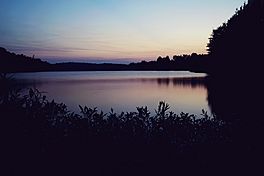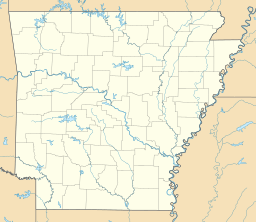Lake Conway facts for kids
Quick facts for kids Lake Conway |
|
|---|---|
 |
|
| Location | Faulkner County, Arkansas, United States |
| Coordinates | 35°00′19″N 92°23′32″W / 35.0053°N 92.3921°W |
| Type | reservoir |
| Primary inflows | Stone Dam Creek, Palarm Creek, Panther Creek, Little Cypress Creek, Gold Creek |
| Basin countries | United States |
| Max. length | 8 mi (13 km) |
| Surface area | 6,700 acres (27 km2) |
| Average depth | 4.5 ft (1 m) |
| Max. depth | 16 ft (5 m) |
Lake Conway is a huge lake in Arkansas, covering about 6,700-acre (27 km2). It's special because it was the first lake ever built by the Arkansas Game and Fish Commission. In fact, it's the largest lake they've ever created!
You can find Lake Conway just east of Mayflower, Arkansas, and a bit southeast of Conway, Arkansas. It's a popular spot for fishing. The lake is home to many kinds of fish, like bass, bluegill, crappie, and different types of catfish. Lake Conway is about 4.5 feet deep on average, but it can go down to 16 feet in some spots. This big lake was built in 1948 by putting a dam across Palarm Creek.
Building Lake Conway
People living in Faulkner County really wanted Lake Conway to be built. They worked hard to make it happen. They had to win many court cases and gather a lot of money to buy the land. The land was bought for about four dollars an acre. At the time, this land was mostly swamp and not good for farming.
The Arkansas Game and Fish Commission was interested in building the lake. They agreed to build the dam if the local residents paid for the land. When people found out about the lake plans, the price of land shot up! It went from four dollars to as much as one hundred dollars an acre.
An early guess for the land cost was twenty thousand dollars, but it ended up being much more. A big campaign started across the state. Over fifty thousand people donated money to help pay for Lake Conway. Some landowners didn't want to sell their land. So, a law called Amendment 35 was passed in 1945. This law used something called eminent domain. It meant the state government could buy the land if they paid a fair price. The Arkansas Supreme Court said this law was legal.
The R. W. Hammock Construction Company built the dam for sixty-five thousand dollars. The finished lake is about eight miles long and has a shoreline of fifty-two miles. Lake Conway officially opened on July 4, 1951. Over 18,000 people came to celebrate! Experts thought the lake would bring in many visitors each year. They estimated it would add over $1,000,000 to the local economy (when thinking about today's money). When the lake first opened, it was stocked with bream, bass, crappie, and even 200 frogs.
Fishing Fun at Lake Conway
Lake Conway can be tricky for new boaters. There are many tree stumps and logs hidden under the water. To help, the Arkansas Game and Fish Commission made special boating lanes. These lanes help boaters move safely around the lake. There are also public docks and easy-to-reach fishing spots for everyone.
Lake Conway is famous for its large crappie fish. To help these fish grow big, there's a rule: you can only keep crappie that are at least 10 inches long. On the east side of the lake, there's a special nursery pond. This pond is very important for keeping many crappie in the lake. Young crappie, called fingerlings, grow in this pond. They stay there until they are big enough to survive in the main lake without being eaten by other fish. Then, they are released into the lake through a canal. Before 1968, there were hardly any crappie in Lake Conway. After the nursery pond was built, the number of crappie grew a lot!
The Mayflower Oil Spill (and How Lake Conway Was Protected)
On March 29, 2013, an oil pipeline broke in Mayflower. Because of this, twenty-two homes had to be evacuated. The pipeline was quickly shut off once the leak was found. Workers cleaned up over 12,000 barrels of oil and water from the area.
Officials from the Environmental Protection Agency and the Department of Transportation came to check out the situation. People were worried that the oil might reach Lake Conway. This was because the oil could flow through a storm drain system that led to a part of the lake. Luckily, local police and firefighters acted fast. They built special barriers, called dikes, to stop the oil from reaching the lake. Exxon, the company involved, also provided nearly 3,600 feet of special floating barriers, called booms, just in case. These efforts helped protect Lake Conway from the oil spill.


